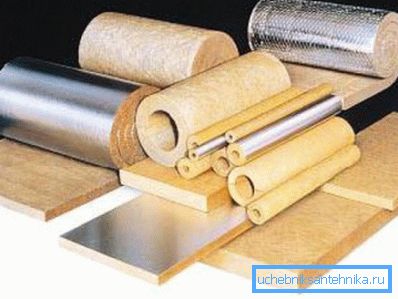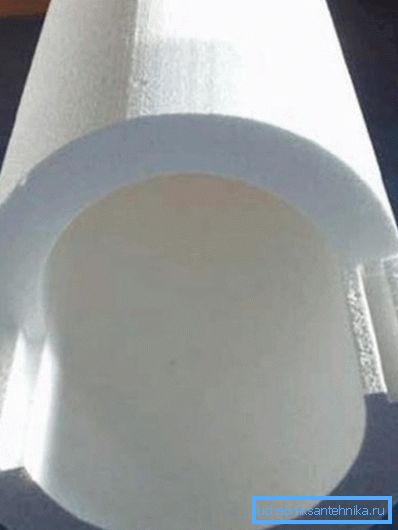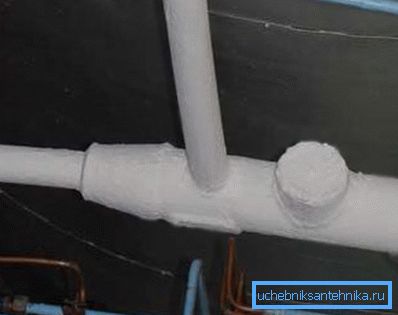How to choose a heater for pipes: the advantages and
For the normal functioning of most engineering networks, it is necessary to ensure their protection from temperature fluctuations of the surrounding air. For this purpose, a heater is used for pipes made of expanded polystyrene or other similar materials in technical characteristics.
They prevent freezing of water in the water supply system and reduce heat loss in the heating system. Let us dwell on this issue in more detail.

Requirements for thermal insulation material
Pipe insulation should meet the following criteria:
- easy to install yourself without using special tools;
- have a long service life;
- do not ignite when exposed to open flame and do not sustain combustion (this is especially important when the chimney warmer is chosen);
- be sealed;
- its price should be affordable.
In addition, pipe insulation is a material that must have the following technical characteristics:
- low thermal conductivity;
- have good heat-saving properties;
- maintain its quality under the influence of moisture (including liquid, which condenses on the water supply pipes);
- be resistant to aggressive chemical elements;
- to withstand the heating of the outer edges of pipelines without the use of additional funds;
- be an insulator - do not conduct electrical current.

Tip! The choice of material should be based on the individual characteristics of the construction object. For example, mineral wool is not suitable for insulation of sewage and water pipes laid in the soil, and the foam should not be used in places of possible fire.
Classification of insulation
Before proceeding to the consideration of specific materials used for the insulation of various pipes, consider their main areas of application.
According to this criterion, insulators are divided:
- materials for protection of hot and cold water pipelines, central heating systems and related devices;
- products for heat insulation of sewer and other similar systems;
- insulation for furnaces and ventilation systems.
In the form of release of insulation materials are:
- in rolls;
- in sheets;
- in the form of casings;
- potting;
- combined.

Types of insulation materials for pipes
Styrofoam
This is a very popular material for warming plumbing systems.
Consider some of its advantages:
- most often used as insulation for water pipes and is available in the form of finished parts (shell) of different diameters;
- can be used both independently and in conjunction with other materials (for example, waterproofing);
- its installation does not require the manufacture of mounting trays;
- It is used both inside the house and when laying the engineering networks.

The installation instructions for this heater are extremely simple:
- you get the right amount of foam shells to insulate pipes of a certain diameter;
- two halves are put on the water supply section and secured with a special lock;
- for extra strength, insulation can be taped;
- in the joints, the insulator should be mounted with an overlap to avoid the appearance of cold bridges.
Note! The features of expanded polystyrene make it easy to dismantle it and install it again in the right places.
Polyethylene foam
Such material is less common, but more convenient for arranging thermal insulation. It is used as insulation for sewer pipes and other similar networks.
Polyethylene foam has the following indisputable advantages:
- flexibility;
- long service life;
- elasticity;
- good thermal insulation characteristics;
- high sound absorption coefficient;
- environmental friendliness;
- affordable cost.

Alternative materials
In addition to the above, there are other materials that are used to isolate water transport systems and as insulation for chimney pipes.
| Material | Specifications |
| Fiberglass | Very good insulation for polymer pipes, which has a low density. However, it requires additional measures for waterproofing, which increases the cost and time of installation. |
| Basalt insulation | It has a very low thermal conductivity and an additional foil protective layer. It is delivered in the form of finished parts of a certain diameter (like foam plastic), is easy to install and does not require preparatory work before installation. The disadvantage is the high cost. |
| Penofol | Enough new insulation with an additional protective layer of metal foil. It is a polyethylene foam of various density. Sold in rolls, which facilitates its installation on pipes of different diameters, laid in hard to reach places. |
| Polyurethane foam | This is a very effective insulation for pipes that can significantly reduce heat loss in the heating system. It is mounted on a polymer pipe at the manufacturing stage. |
| Penoizol | It has technical characteristics similar to foam insulation. Sold in the form of a special mixture that is applied to the pipe using special tools. It has sealing properties. Perfectly is suitable for processing of the pipes located on the street. |

Heat insulation paint
This material is easy to apply and absolutely does not increase the size of the pipeline.
Despite this, heat-insulating paint has the following technical characteristics:
- has a low thermal conductivity;
- protects metal parts from rust;
- prevents condensation of moisture on the surface of the pipe;
- retains its properties at extreme temperatures;
- has a long service life;
- applied to the pipe with a brush or spray;
- it can cover pipes in hard to reach places;
- improves the appearance of the pipeline.
After solidification, the composition provides the same level of thermal insulation as regular mineral wool.

Tip! High-tech insulating paint should be used to protect pipes in cases where the use of other materials is not possible.
The need to isolate individual systems
Heating
These networks need to be isolated in the case when the pipeline is laid on the street, passes in unheated rooms or is walled in a concrete wall. If this is not done, the efficiency of the heating system is greatly reduced, which increases the cost of utilities.
Most often for work mineral wool is used. But recently polyurethane foam, fibrous heat insulators and penoplex are becoming increasingly popular.
It must be remembered that the heat line is often subjected to attacks of rodents in the winter. Therefore, it is necessary to provide for the protection of the heat insulator from them, or to choose a more specific material.

Water pipes
In this case, the task is to prevent the water passing through the pipes to freeze. If water pipes were used to design the water supply, the thermal insulation will help protect the system from corrosion.
The most suitable insulation is liquid polyurethane foam, which is easy to apply and, in addition to insulation, protects pipes from condensation. This increases the duration of operation of the engineering network.

Sewage
The question of whether it is necessary to warm the pipes of the sewer network is decided individually in each case.
To avoid the formation of ice in the sewage system during the winter, the following rules should be followed during installation:
- pipes should be laid in the ground at a depth of at least 1.6-1.8 meters (below the level of soil freezing);
- sewage system should have a certain slope (about 3 cm per 1 meter);
- When designing a wastewater disposal system, it is advisable to provide for the smallest possible number of turns and curvatures that contribute to the occurrence of sewage blockages.

Conclusion
Insulation for heating pipes in the open air, as well as insulation material for water supply and wastewater systems, are necessary elements of the listed engineering networks, without which their normal operation is impossible. More details about this can be found in the video in this article.